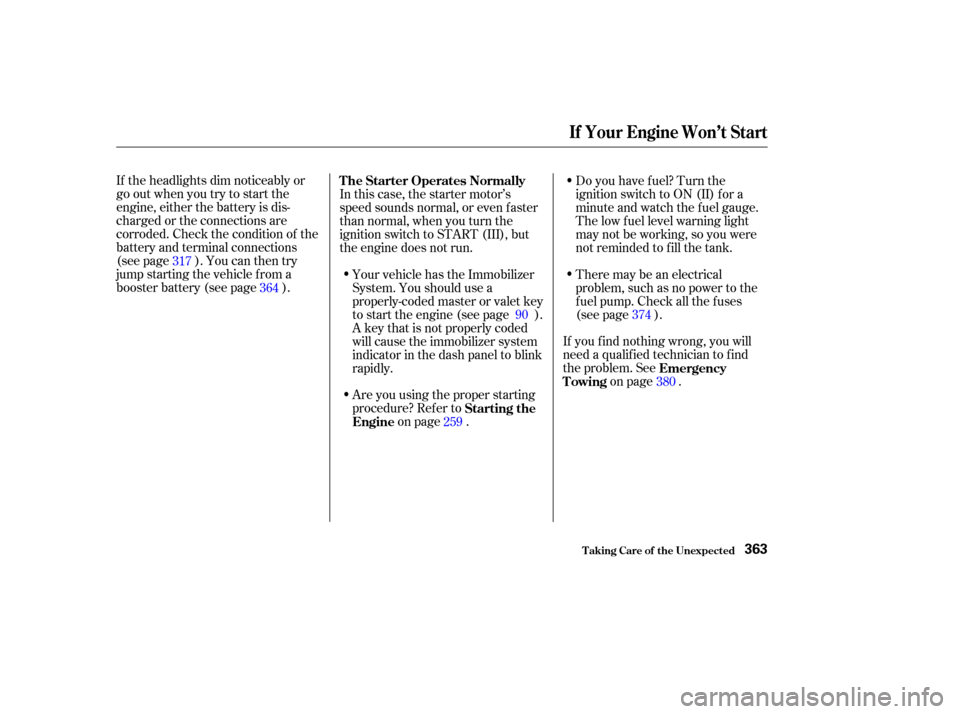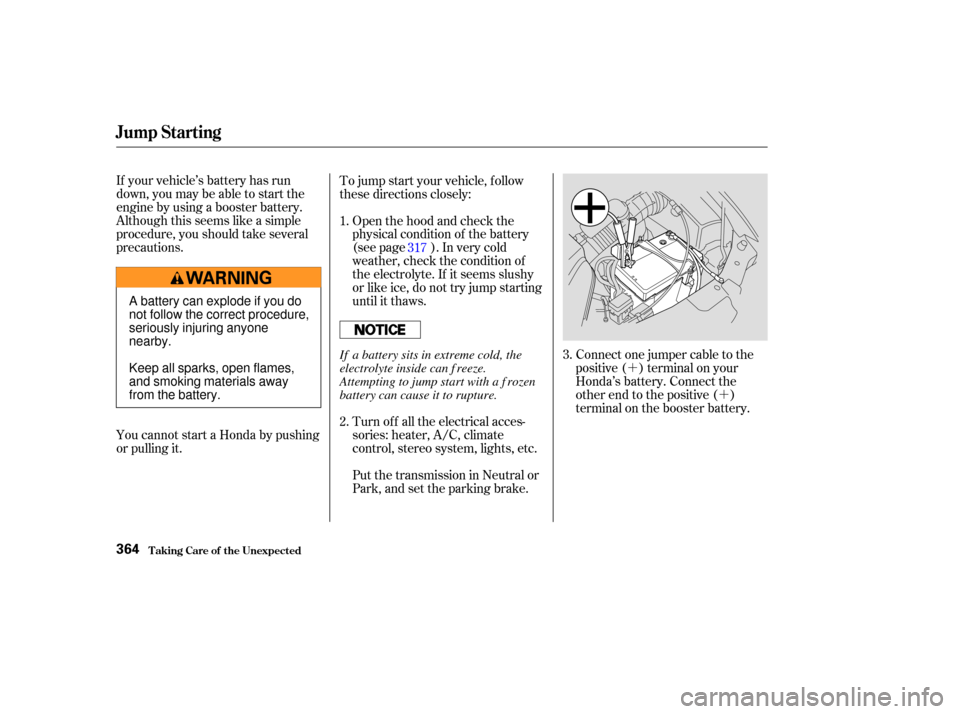Page 342 of 415
Remove the bulb by pulling it
straight out of its metal tabs.Push the new bulb into the metal
tabs. Snap the lens back in place.
Front individual map light:
Pry on the f ront edge in f ront of both
map lights.
Rear individual map light:
Pry on the middle edge of the lens
near the vent.
Cargo area light:
Pry on the rear edge to the lef t and
right of center.
3.
2.
CONT INUED
Lights
Maint enance339
REAR INDIVIDUAL MAP LIGHT CARGO AREA LIGHT
Page 343 of 415
Lights
Maint enance340
SUN VISOR
Page 356 of 415
If you have a f lat tire while driving,
stop in a saf e place to change it.
Stopping in traf f ic or on the shoulder
of a busy road is dangerous. Drive
slowly along the shoulder until you
gettoanexitoranareatostopthat
is far away from the traffic lanes.Park the vehicle on f irm, level, and
non-slippery ground away f rom
traffic. Put the transmission in
Park. Apply the parking brake.
If you are towing a trailer, unhitch
the trailer.Turn on the hazard warning lights,
and turn the ignition switch to
LOCK (0). Have all the
passengers get out of the vehicle
while you change the tire.
2.
1.
CONT INUED
Changing a Flat T ire
T aking Care of t he Unexpect ed353
JACK VINYL BAG
SPARE TIRE
TOOLS
The vehicle can easily roll off
the jack, seriously injuring
anyone underneath.
Follow the directions for
changing a tire exactly, and
never get under the vehicle
when it is supported only by the
jack.
Page 365 of 415

Diagnosing why your engine won’t
start f alls into two areas, depending
on what you hear when you turn the
key to START (III):You hear nothing, or almost
nothing. The engine’s starter
motor does not operate at all, or
operates very slowly.
You can hear the starter motor
operating normally, or the starter
motor sounds like it is spinning
f aster than normal, but the engine
does not start up and run. Turn the ignition switch to START
(III). If the headlights do not dim,
check the condition of the f uses. If
the f uses are OK, there is proba-
bly something wrong with the
electrical circuit f or the ignition
switch or starter motor. You will
need a qualif ied technician to
determine the problem. (See
on page .)
When you turn the ignition switch to
START (III), you do not hear the
normal noise of the engine trying to
start. You may hear a clicking sound
or series of clicks, or nothing at all.
Check these things:
Check the transmission interlock.
The transmission must be in Park
orNeutralorthestarterwillnot
operate.
Turn the ignition switch to ON (II).
Turn on the headlights and check
their brightness. If the headlights
are very dim or don’t light at all,
the battery is discharged. See on page . 380
364
T aking Care of t he Unexpect ed
If Your Engine Won’t Start
Emergency T owing
Nothing Happens or the Starter
Motor Operates Very Slowly
Jump Starting
362
Page 366 of 415

If the headlights dim noticeably or
go out when you try to start the
engine, either the battery is dis-
charged or the connections are
corroded. Check the condition of the
battery and terminal connections
(see page ). You can then try
jump starting the vehicle from a
booster battery (see page ).In this case, the starter motor’s
speed sounds normal, or even f aster
than normal, when you turn the
ignition switch to START (III), but
the engine does not run.
Are you using the proper starting
procedure? Ref er to on page . There may be an electrical
problem, such as no power to the
f uel pump. Check all the f uses
(see page ).
If youfindnothingwrong,youwill
need a qualif ied technician to f ind
the problem. See on page .
Your vehicle has the Immobilizer
System. You should use a
properly-coded master or valet key
to start the engine (see page ).
A key that is not properly coded
will cause the immobilizer system
indicator in the dash panel to blink
rapidly. Do you have f uel? Turn the
ignition switch to ON (II) for a
minute and watch the f uel gauge.
The low f uel level warning light
may not be working, so you were
not reminded to f ill the tank.
317
364
259 374
380
90
T he Starter Operates Normally
Starting the
Engine Emergency
Towing
If Your Engine Won’t Start
T aking Care of t he Unexpect ed363
Page 367 of 415

�´�´
If your vehicle’s battery has run
down,youmaybeabletostartthe
engine by using a booster battery.
Although this seems like a simple
procedure, you should take several
precautions.
You cannot start a Honda by pushing
or pulling it. To jump start your vehicle, f ollow
these directions closely:
Open the hood and check the
physical condition of the battery
(see page ). In very cold
weather, check the condition of
the electrolyte. If it seems slushy
or like ice, do not try jump starting
until it thaws.
Turn of f all the electrical acces-
sories: heater, A/C, climate
control, stereo system, lights, etc.
Put the transmission in Neutral or
Park, and set the parking brake. Connect one jumper cable to the
positive ( ) terminal on your
Honda’s battery. Connect the
other end to the positive ( )
terminal on the booster battery.
1.
2.
3.
317
T aking Care of t he Unexpect ed
Jump Starting
364
A battery can explode if you do
not follow the correct procedure,
seriously injuring anyone
nearby.
Keep all sparks, open flames,
and smoking materials away
from the battery.
If a battery sits in extreme cold, the
electrolyte inside can f reeze.
Attempting to jump start with a f rozen
battery can cause it to rupture.
Page 378 of 415

CONT INUED
The secondary f use box is in the
engine compartment next to the
battery.If something electrical in your
vehicle stops working, the first thing
youshouldcheckforisablownfuse.
Determine f rom the chart on page
to , or the diagram on the
f use box lid (the diagram f or the
driver’s side interior f use box is on
the kick panel below the f use box),
which f use or f uses control that
component. Check those f uses f irst,
but check all the f uses bef ore
deciding that a blown f use is not the
cause. Replace any blown f uses and
check the component’s operation.
Turn the ignition switch to LOCK
(0). Make sure the headlights and
all other accessories are off.
Remove the cover f rom the f use
box. Check each of the large f uses in
the primary under-hood f use box
by looking through the top at the
wire inside. Removing these f uses
requires a Phillips-head screw-
driver.
1.
2. 379377
3.
Fuses
T aking Care of t he Unexpect ed
Checking and Replacing Fuses
375
FUSE
BLOWN
SECONDARY UNDER-HOOD FUSE BOX
Page 382 of 415

�Î�Î
�Î �Î
�Î
�Î �Î
�Î
On Canadian models
1
2
3
4
5
6
7
8
9
10
11
12
13 15 A
10 A
7.5 A
7.5 A
7.5 A 15 A
15 A
7.5 A 10 A
7.5 A 10 A
30 A
7.5 A Fuel Pump
SRS
Heater Control, A/C Clutch
Relay, Cooling Fan Relay
Power Mirror
Daytime Running Light
ECU(PCM),CruiseControl
IG Coil
ACC Relay
Back-up Lights, Instrument
Lights
Turn Signals
Rear Wiper
Front Wiper
Starter Signal Driver’s Side Automatic
Sliding Door
Power Seat Reclining
BSC
Power Seat Sliding
Passenger’s Side Automatic
Sliding Door
Daytime Running Light
Left Rear Window
Front Passenger’s Power
Window
ACC Socket
Inst. Panel Light, License
Light
Interior Light, Radio
Power Door Locks
Clock, Back Up
ABS Motor Check
Driver’s Power Window
Right Rear Window
1
2
3
4
5
6
7
8
9
10
11
12
13
14
15
16 20 A
20 A
10 A
20 A
20 A
10 A
7.5 A 20 A
15 A
15 A
10 A
20 A
7.5 A
7.5 A 20 A
7.5 A
1:
2: EX and EX-L models
Canadian models
No. Amps. Circuits Protected
Circuits Protected
No. Amps.
1
1 1
2
Fuses
T aking Care of t he Unexpect ed379
Driver’s Side INTERIOR FUSE BOX Passenger’s Side
Front Front
: